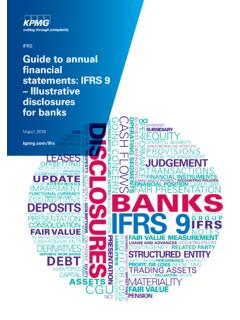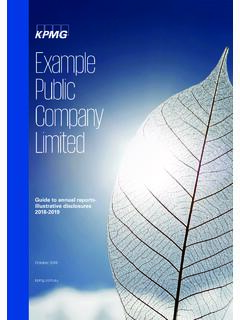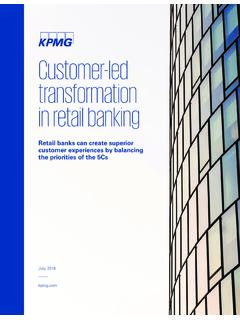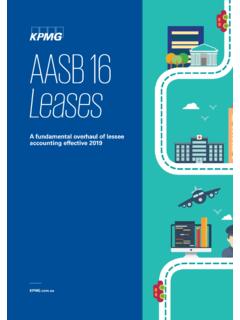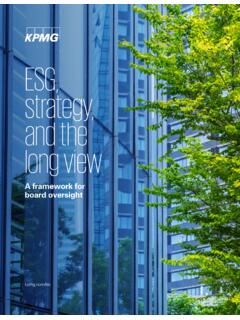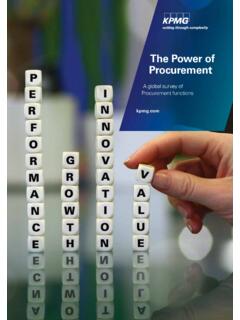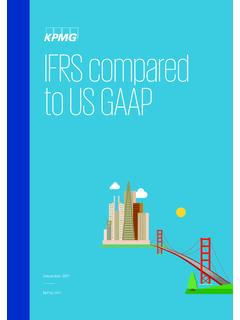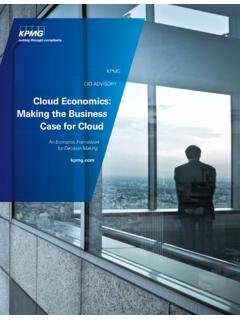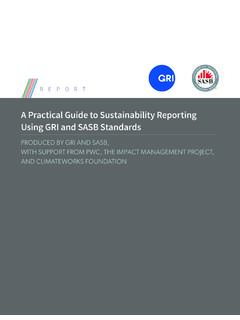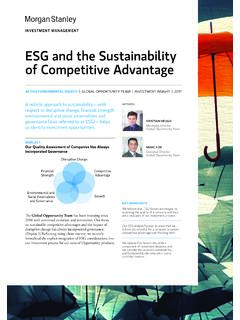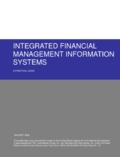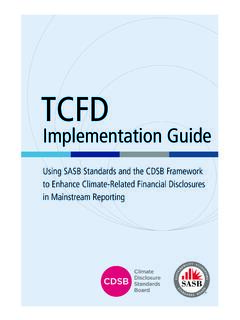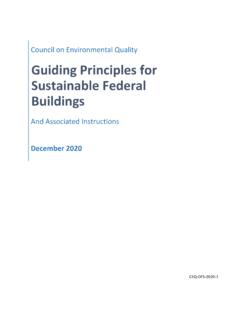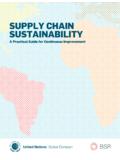Transcription of KPMG INTERNATIONAL Sustainable Insight
1 KPMG INTERNATIONALS ustainable InsightThe essentials of materiality assessment is the principle of defining the social and environmental topics that matter most to your business and your stakeholders. Some 80 percent of the world s largest 250 companies already identify material sustainability issues in their Yet the process of identifying material issues is a challenge that clients of KPMG member firms are increasingly seeking our professional guidance is primarily due to the growing focus on materiality in reporting frameworks and accounting standards, such as the Global reporting Initiative s (GRI) G4 guidelines, the INTERNATIONAL Integrated reporting <IR> Framework and the sustainability Accounting Standards Board (SASB) in the addition, new regulation - such as the European Directive on non-financial reporting2- and increasing stock exchange requirements to report environmental, social and governance (ESG) risks3 are leading companies to consider what non-financial information matters and what they should report.
2 As a result, many companies are looking to revise and update their materiality assessment processes. While many large companies understand the principles of materiality , some struggle to define and implement a robust process. This is reflected in the fact that of the 250 largest companies in the world (by revenue) that define material topics in their sustainability report, 41 percent do not explain the process used and less than half (45 percent) clearly explain how stakeholder input is used to identify material Common challenges with the materiality process include: incorporating and prioritizing stakeholder views, involving senior management, and extending the materiality assessment beyond the company s own operations, across the value believe that in many companies the sustainability materiality process can be significantly improved, better aligned with wider business processes and reported with more clarity.
3 This paper aims to help companies by providing guidance on the materiality assessment process in the light of recent developments in reporting requirements and advice on overcoming common challenges. We set out the key steps companies need to take to establish a robust process and provide solutions to common challenges. The paper is written primarily for sustainability professionals, risk managers and those involved in corporate reporting . We believe that the companies which fully consider how sustainability topics interrelate with their business strategy, and develop sustainability materiality processes that link with the wider enterprise risk management process, will be in a better position to inform investors, regulators and other stakeholders on their environmental, social and governance impacts, risks and KPMG (2013). The KPMG Survey of Corporate Responsibility reporting In April 2014 the European Parliament adopted the directive on disclosure of non-financial and diversity information.
4 It affects around 6,000 large companies in Europe that will need to disclose information on policies, risks and outcomes related to environmental and social issues, human rights, anti-corruption, anti-bribery and diversity. Retrieved 20 October 2014. 3 KPMG, United Nations Environment Programme, Global reporting Initiative and Unit for Corporate Governance in Africa (2013). Carrots and Sticks: sustainability reporting policies worldwide. 4 KPMG (2013). The KPMG Survey of Corporate Responsibility reporting 2013. 2014 KPMG INTERNATIONAL Cooperative 2014 KPMG INTERNATIONAL Cooperative 2 / Sustainable Insight / The essentials of materiality assessmentIn our view, materiality assessment should be used as a strategic business tool, with implications beyond corporate responsibility (CR) or sustainability reporting . Organizations can get most benefit from their materiality process by using it as an opportunity to apply a sustainability lens to business risk, opportunity, trend-spotting and enterprise risk management processes.
5 Rather than creating a separate, isolated process, leading companies embed sustainability within these existing processes. A broad and inclusive materiality process, including stakeholder engagement can deliver valuable benefits, such as: Ensuring business strategy takes account of significant social and environmental topics and the management of sustainability issues is embedded in wider business processes Identifying trends on the horizon, such as water scarcity or changing weather patterns, that could significantly impact your company s ability to create value in the long-term Enabling different functions of the business to be ready to take advantage of opportunities to develop new products or services and stay ahead of competitors Prioritizing your organization s resources for the sustainability issues that matter most to your business and stakeholders, so you can focus time and money on the most important topics.
6 And on collecting relevant data Highlighting areas where you need to manage and monitor issues that are important but not currently addressed Identifying the areas of interest to the most important stakeholders, enabling you to report concise information that gives a meaningful picture of progress to those that need it Helping to identify where the company is creating, or reducing, value for assessment as a strategic business tool4 KPMG s guide to the materiality process to help you navigate the complex landscape of stakeholder expectations, risks and opportunities. It is designed to be a practical guide on the process relevant to all organizations regardless of how established your sustainability strategy and reporting is. 11 Strategies to help resolve common challenges you might face while completing a materiality assessment , from prioritizing stakeholder views to involving senior s materiality Toolkit and Methodology In this paperKPMG s guide to the materiality processImproving your materiality process: overcoming challengesHow we can help041117 2014 KPMG INTERNATIONAL Cooperative 2014 KPMG INTERNATIONAL Cooperative 3 / Sustainable Insight / The essentials of materiality assessmentMateriality assessment is the process of identifying, refining, and assessing numerous potential environmental, social and governance issues that could affect your business, and/or your stakeholders, and condensing them into a short-list of topics that inform company strategy, targets, and reporting .
7 We provide a 7-phase materiality process, aligned with KPMG s materiality Toolkit and Methodology. We have prepared this guide and toolkit based on member firm professionals extensive experience in advising clients, working with enterprise risk management teams and assuring materiality processes. It includes key points to address in each phase, split into two parts: the first part explains the expected elements that we believe are minimum requirements for a robust materiality process. The second part provides more advanced steps for organizations with a more established sustainability strategy. You can expect that your third-party assurance providers will look for documented evidence of each step. KPMG s guide to the materiality process 2014 KPMG INTERNATIONAL Cooperative 2014 KPMG INTERNATIONAL Cooperative 4 / Sustainable Insight / The essentials of materiality assessmentThere is no one universally agreed definition or approach for determining material topics, leaving companies free to develop their own approach.
8 KPMG s approach is not designed to adhere to one specific reporting framework. It is aligned with the principles of the GRI G4 s process, and can be tailored to apply in an Integrated reporting context. In member firms experience, companies often struggle to navigate the different requirements of reporting frameworks. We believe it is possible to have one reporting process and to produce one primary report to communicate material topics: Both <IR> and G4 have a similar approach to materiality in that they are both principles-based, rather than rules-based. Both frameworks put more emphasis on the process of the assessment , rather than setting any requirements for the outcome of a materiality assessment . KPMG has analyzed the two materiality definitions and we believe that if value creation is the common denominator to filter material topics then a bridge can be established between the two definitions.
9 For companies in the US, whilst SASB s sector approach may provide insights into the material topics investors may expect your organization to report on, you will still need to perform your own materiality assessment . Doing so will give you vital information on stakeholder views and enable you to identify material topics relevant to your particular geographies and business model. More information on the alignment between two global, well-known reporting standards can be found in: Bridging the gap between Integrated and GRI G4 reporting (KPMG, September 2014).5 Aligning your materiality process with reporting frameworks5 2014 KPMG INTERNATIONAL Cooperative 2014 KPMG INTERNATIONAL Cooperative 5 / Sustainable Insight / The essentials of materiality assessmentPHASE 1: Define purpose and scopeDefine what materiality means for your organization and be clear about your objectives and audience PHASE 2: Identify potential topicsCreate a long-list of potential material topicsPHASE 4: Gather information about the impact and importance of topicsExplore each material topic in detail to understand its relevance to the business and stakeholders PHASE 5: PrioritizePrioritize material topics based on the strategic importance to the business, importance to stakeholders and the social, economic and environmental impact of each topic in the value chainPHASE 6.
10 Engage managementTest the results of your materiality assessment with key internal audiences to validate the outcomePHASE 7: Seek stakeholder feedbackFollow up with stakeholders to get feedback on the material topics reportedPHASE 3: Categorize Refine the long-list of potential material topics by clustering them into categoriesKPMG s guide to the materiality process6 / Sustainable Insight / The essentials of materiality assessmentSource: KPMG (2014). Sustainable Insight : the essentials of materiality assessment . 2014 KPMG INTERNATIONAL Cooperative 2014 KPMG INTERNATIONAL Cooperative 6 / Sustainable Insight / The essentials of materiality assessmentPHASE 1: Define what materiality means for your organization and be clear about your objectives and audienceExpected Define the objectives of the materiality assessment . Consider what you will do with the outcome of the process.
